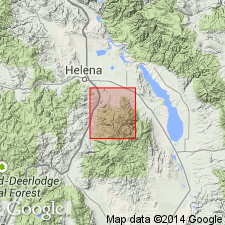
- Usage in publication:
-
- Kokoruda Ranch complex*
- Modifications:
-
- Named
- Dominant lithology:
-
- Gabbro
- Granodiorite
- Monzonite
- AAPG geologic province:
-
- Montana folded belt
Summary:
Named after George C. Kokoruda ranch located in sec 28, T9N, R2W, Jefferson Co, MT. No type locality designated. Occurs over area of 3 1/3 sq mi at Little Butte at north end of Elkhorn Mountains, Montana folded belt province. Consists of wide range of rocks including granodiorite, granogabbro, gabbro, norite, syenogabbro, syenodiorite, monzonite, calcic monzonite, augite-bearing quartz monzonite and rare bands of peridotite in gabbro. Topographic expression is gently rolling hills and flat fields with fair to poor exposures. [Thickness not discussed]. Is oldest unit of Boulder batholith. Overlies Elkhorn Mountains Volcanics; underlies granodiorite of Antelope Creek stock of Boulder batholith. Intrudes Elkhorn Mountains Volcanics and Colorado Formation, probably along preexisting north-or north-northeast-trending faults; also cuts Kootenai and Morrison Formations. Mapped with other mafic rocks including a dike and plugs. Table of composition and petrographic features. Correlates with and includes gabbro of the Knapp stock and Unionville Granodiorite, both of Knopf (1963). Late Cretaceous or Paleocene age based on stratigraphic position and radiometric dates on rocks of Boulder batholith by other workers.
Source: GNU records (USGS DDS-6; Denver GNULEX).
For more information, please contact Nancy Stamm, Geologic Names Committee Secretary.
Asterisk (*) indicates published by U.S. Geological Survey authors.
"No current usage" (†) implies that a name has been abandoned or has fallen into disuse. Former usage and, if known, replacement name given in parentheses ( ).
Slash (/) indicates name conflicts with nomenclatural guidelines (CSN, 1933; ACSN, 1961, 1970; NACSN, 1983, 2005, 2021). May be explained within brackets ([ ]).

